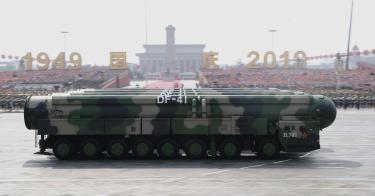The U.S. government used to keep the public apprised of threats to national security.
Recall, for example, when President John F. Kennedy went on national TV to inform the public about Soviet missiles in Cuba. Such news was never welcome, but the public appreciated knowing the hard truths.
Today, it is increasingly common for the public to get this kind of news from private organizations, with Washington later acknowledging it only grudgingly, if at all. This trend raises concerns about whether we can continue to count on the government to provide candid security assessments.
The Washington Post recently highlighted how it was researchers at the Federation of American Scientists and the James Martin Center for Nonproliferation Studies, not the federal government, who, using commercial imagery, reported finding two sites where over 100 new missile silos each were under construction in China. At roughly the same time, analysts at AllSource Analysis, a private firm, again using commercial images, reported the new construction of a tunnel at a known Chinese test site. This has fueled speculation Beijing may be planning to resume some form of nuclear testing.
U.S. Strategic Command, responsible for the U.S. nuclear deterrent, seemed actually relieved the cat was out of the bag, stating on its Twitter account that "this is the second time in two months the public has discovered what we have been saying all along about the growing threat the world faces and the veil of secrecy that surrounds it."
These independent assessments are made possible by the now ubiquitous availability of commercial imagery. When Iran pelted U.S. forces at Al Asad Airbase in Iraq with ballistic missiles, news organizations had to use private, not U.S. government, imagery to show the extent of the damage. Similarly, commercial cellphone data can now be easily mined to find movements of troops overseas.
But in the case of the Chinese nuclear developments, the question must be asked: Why didn’t the U.S. government see fit to let the public know of these alarming developments? With their advanced intelligence satellites and dedicated analysts, the government surely knew about the new missile sites for months before these private organizations figured it out. If commercial imagery detected the construction, it can't be that the government didn't want to compromise U.S. spy satellite capabilities.
A more cynical and likely interpretation would suggest that to confirm the Chinese are engaged in a wholesale effort to strengthen their nuclear arsenal would run counter-narrative for the Biden administration. Its declared policy is to "reduce the role of nuclear weapons in our national security strategy" and "head off costly arms races."
Reducing the role of nuclear weapons and avoiding arms races might be a viable strategy if your potential adversaries share those goals. But the facts suggest otherwise. Vladimir Putin recently boasted his nuclear modernization initiative was approximately 86% complete. Moreover, Moscow has started six new, destabilizing strategic weapons programs. As for China, the Trump administration’s 2020 China Military Power report predicted Beijing intended to double its nuclear arsenal within the decade. Last month’s discovery of the new missile fields now leads some analysts to postulate China may in fact quadruple its nuclear holdings. It looks like Putin and Xi didn’t get the memo about reducing the role of nuclear weapons.
Over time, the public proved it can handle hard truths. And many of today’s hard truths suggest that the Biden administration needs to invest more in national defense. The public shouldn’t have to accept learning about alarming new threats from third parties and private companies.
This piece originally appeared in the Washington Examiner




